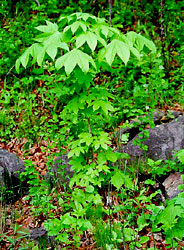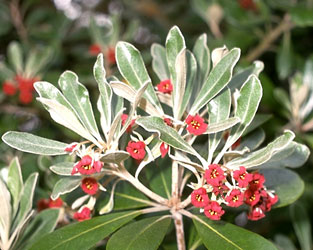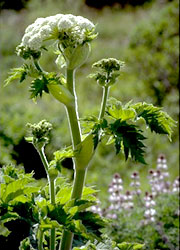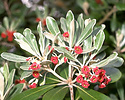Apiales



This tree diagram shows the relationships between several groups of organisms.
The root of the current tree connects the organisms featured in this tree to their containing group and the rest of the Tree of Life. The basal branching point in the tree represents the ancestor of the other groups in the tree. This ancestor diversified over time into several descendent subgroups, which are represented as internal nodes and terminal taxa to the right.

You can click on the root to travel down the Tree of Life all the way to the root of all Life, and you can click on the names of descendent subgroups to travel up the Tree of Life all the way to individual species.
For more information on ToL tree formatting, please see Interpreting the Tree or Classification. To learn more about phylogenetic trees, please visit our Phylogenetic Biology pages.
close boxReferences
Albach, D. C., P. S. Soltis, D. E. Soltis, and R. G. Olmstead. 2001. Phylogenetic analysis of asterids based on sequences of four genes. Annals of the Missouri Botanical Garden 88:163-212.
Backlund, A. and B. Bremer. 1997. Phylogeny of Asteridae s. str. based on rbcL sequences, with particular reference to Dipsacales. Plant Systematics and Evolution 207:225-254.
Bremer, K., A. Backlund, B. Sennblad, U. Swenson, K. Andreasen, M. Hjertson, J. Lundberg, M. Backlund, and B. Bremer. 2001. A phylogenetic analysis of 100+ genera and 50+ families of euasterids based on morphological and molecular data with notes on possible higher level morphological synapomorphies. Plant Systematics and Evolution 229:137-169.
Bremer, B., K. Bremer, N. Heidari, P. Erixon, R. G. Olmstead, A. A. Anderberg, M. Källersjö, and E. Barkhordarian. 2002. Phylogenetics of asterids based on 3 coding and 3 non-coding chloroplast DNA markers and the utility of non-coding DNA at higher taxonomic levels. Molecular Phylogenetics and Evolution 24:274-301.
Chandler, G. T. and G. M. Plunkett. 2004. Evolution in Apiales: nuclear and chloroplast markers together in (almost) perfect harmony.
Botanical Journal of the Linnean Society 144(2):123-147.
Kårehed, J. 2003. The family Pennantiaceae and its relationships to Apiales. Botanical Journal of the Linnean Society 141(1): 1-24.
Liu, M. (R.), G. M. Plunkett, P. P. Lowry, II, B.-E. Van Wyk, and P. M. Tilney. 2006. The taxonomic value of fruit wing types in the order Apiales. American Journal of Botany 93:1357-1368.
Lowry, P. P., II, G. M. Plunkett, and A. A. Oskolski. 2001. Early lineages in Apiales: Insights from morphology, wood anatomy and molecular data. Edinburgh Journal of Botany 58:207-220.
Olmstead, R. G., K.-J. Kim, R. K. Jansen, and S. J. Wagstaff. 2000. The phylogeny of the Asteridae sensu lato based on chloroplast ndhF gene sequences. Molecular Phylogenetics and Evolution 16:96-112.
Oskolski. A. A. 2001. Phylogenetic relationships within Apiales: Evidence from wood anatomy. Edinburgh Journal of Botany 58:201-206.
Plunkett, G. M. 2001. Relationship of the order Apiales to subclass Asteridae: a re-evaluation of morphological characters based on insights from molecular data. Edinburgh Journal of Botany 58:183-200.
Plunkett, G. M. and P. P. Lowry II. 2001. Relationships among "ancient Araliads" and their significance for the systematics of Apiales. Molecular Phylogenetics and Evolution 19:259-276.
Plunkett, G. M., D. E. Soltis, and P. S. Soltis. 1996. Higher level relationships involving Apiales (Apiaceae and Araliaceae) based on phylogenetic analysis of rbcL sequences. American Journal of Botany 83:499-515.
Savolainen, V., M. F. Fay, D. C. Albach, A. Backlund, M. van der Bank, K. M. Cameron, S. A. Johnson, M. D. Lledó, J.-C. Pintaud, M. Powell, M. C. Sheahan, D. E. Soltis, P. S. Soltis, P. Weston, W. M. Whitten, K. J. Wurdack, and M. W. Chase. 2000. Phylogeny of the eudicots: a nearly complete familial analysis based on rbcl gene sequences. Kew Bulletin 55:257-309.
Soltis, D. E., P. S. Soltis, M. W. Chase, M. E. Mort, D. C. Albach, M. Zanis, V. Savolainen, W. H. Hahn, S. B. Hoot, M. F. Fay, M. Axtell, S. M. Swensen, L. M. Prince, W. J. Kress, K. C. Nixon, and J. S. Farris. 2000. Angiosperm phylogeny inferred from 18S rDNA, rbcL, and atpB sequences. Botanical Journal of the Linnean Society 133:381-461.
Information on the Internet
- Apiales Internet Resource Centre
- Systematics, evolution, and biogeography of Apiales (Araliaceae + Apiaceae). Greg Plunkett Lab, Virginia Commonwealth University.
Title Illustrations

| Scientific Name | Kalopanax septemlobus |
|---|---|
| Location | Vladivostok suburb, Primorsky Territory (Russian Federation) |
| Comments | Castor aralia (Araliaceae) |
| Specimen Condition | Live Specimen |
| Source Collection | CalPhotos |
| Copyright |
© 1999
Nick Kurzenko

|
| Scientific Name | Pittosporum crassifolium |
|---|---|
| Location | Golden Gate Park (San Francisco County, California, USA) |
| Comments | Stiffleaf cheesewood (Pittosporaceae) |
| Creator | Photograph by J.W. Thompson |
| Specimen Condition | Live Specimen |
| Source Collection | CalPhotos |
| Copyright |
© 1999 California Academy of Sciences

|
| Scientific Name | Heracleum lanatum (Apiaceae) |
|---|---|
| Location | Point Reyes National Seashore (Marin County, California, USA) |
| Creator | Photograph by Jo-Ann Ordano |
| Specimen Condition | Live Specimen |
| Source Collection | CalPhotos |
| Copyright |
© 2000 California Academy of Sciences

|
About This Page
Page copyright © 2002
All Rights Reserved.
Citing this page:
Tree of Life Web Project. 2002. Apiales. Version 01 January 2002 (temporary). http://tolweb.org/Apiales/20741/2002.01.01 in The Tree of Life Web Project, http://tolweb.org/











 Go to quick links
Go to quick search
Go to navigation for this section of the ToL site
Go to detailed links for the ToL site
Go to quick links
Go to quick search
Go to navigation for this section of the ToL site
Go to detailed links for the ToL site